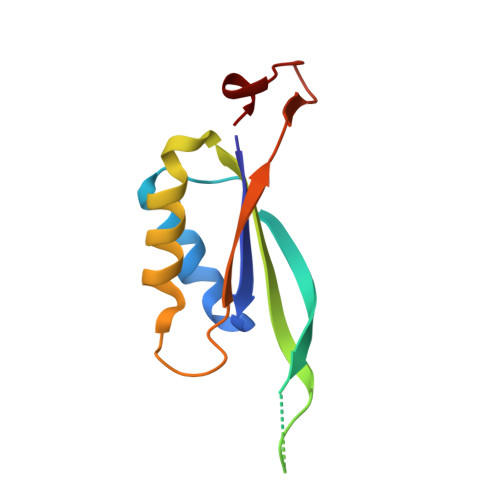Herbaspirillum seropedicae signal transduction protein PII is structurally similar to the enteric GlnK.
Machado Benelli, E., Buck, M., Polikarpov, I., Maltempi de Souza, E., Cruz, L.M., Pedrosa, F.O.(2002) Eur J Biochem 269: 3296-3303
- PubMed: 12084071
- DOI: https://doi.org/10.1046/j.1432-1033.2002.03011.x
- Primary Citation of Related Structures:
1HWU - PubMed Abstract:
PII-like proteins are signal transduction proteins found in bacteria, archaea and eukaryotes. They mediate a variety of cellular responses. A second PII-like protein, called GlnK, has been found in several organisms. In the diazotroph Herbaspirillum seropedicae, PII protein is involved in sensing nitrogen levels and controlling nitrogen fixation genes. In this work, the crystal structure of the unliganded H. seropedicae PII was solved by X-ray diffraction. H. seropedicae PII has a Gly residue, Gly108 preceding Pro109 and the main-chain forms a beta turn. The glycine at position 108 allows a bend in the C-terminal main-chain, thereby modifying the surface of the cleft between monomers and potentially changing function. The structure suggests that the C-terminal region of PII proteins may be involved in specificity of function, and nonenteric diazotrophs are found to have the C-terminal consensus XGXDAX(107-112). We are also proposing binding sites for ATP and 2-oxoglutarate based on the structural alignment of PII with PII-ATP/GlnK-ATP, 5-carboxymethyl-2-hydroxymuconate isomerase and 4-oxalocrotonate tautomerase bound to the inhibitor 2-oxo-3-pentynoate.
- Department of Biochemistry, Universidade Federal do Paraná, C. Postal 19046, Curitiba, Brazil. benelli@bio.ufpr.br
Organizational Affiliation:
















